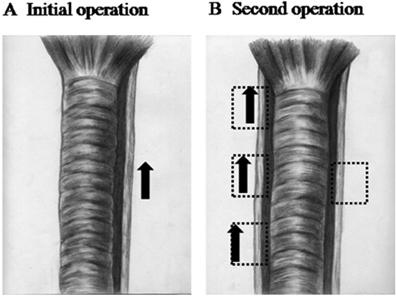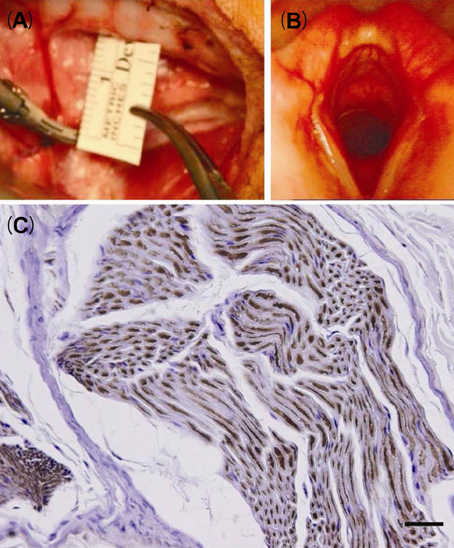Lab Anim Res.
2012 Dec;28(4):223-228. 10.5625/lar.2012.28.4.223.
Development of a canine model for recurrent laryngeal injury by harmonic scalpel
- Affiliations
-
- 1Department of Surgery, Seoul National University Hospital & College of Medicine, Seoul, Korea. ykyoun@plaza.snu.ac.kr
- 2Cancer Research Institute, Seoul National University College of Medicine, Seoul, Korea.
- 3Department of Surgery, Korea University Anam Hospital, Seoul, Korea.
- 4Department of Surgery, Kyunghee University Medical Center, Seoul, Korea.
- 5Department of Pathology, Seoul National University Hospital & College of Medicine, Seoul, Korea.
- KMID: 1431403
- DOI: http://doi.org/10.5625/lar.2012.28.4.223
Abstract
- Various energy devices had been used in thyroid surgery. Aim of study is to develop canine model for recurrent laryngeal nerve injury by harmonic scalpel and to evaluate feasibility of using this model for evaluating the safety use of harmonic scalpel during thyroid surgery. Nine dogs were divided into 3 groups according to distance between harmonic scalpel application and recurrent laryngeal nerve; group 1 (1 mm), 2 (2 mm), and 3 (3 mm). Vocal cord function was assessed pre- and postoperatively using video laryngoscopy. Harmonic scalpel was applied adjacent to left recurrent laryngeal nerve and, two weeks later, right recurrent laryngeal nerve at assigned distances. Recurrent laryngeal nerves were evaluated for subacute and acute morphologic changes. Laryngoscopy demonstrated 3 abnormal vocal cords in group 1, 1 in group 2, and no in group 3 (P=0.020). Subacute histologic changes were observed in nerves with abnormal function. Acute histologic changes were observed 5/8 (62.5%) in group 1, 1/7 (14.3%) in group 2, and not in group 3. We developed canine model for recurrent laryngeal injury. The functional outcomes matched with the histologic changes. These warrant further study to determine the safety margin for energy device in vicinity of recurrent laryngeal nerve.
Keyword
MeSH Terms
Figure
Cited by 1 articles
-
Comparing the safety of harmonic ACE and ACE+ around the recurrent laryngeal nerve in swine models
Hong Kyu Kim, Young Jun Chai, Hye Yoon Lee, Hoon Yub Kim, Gianlorenzo Dionigi
Ann Surg Treat Res. 2018;94(6):285-290. doi: 10.4174/astr.2018.94.6.285.
Reference
-
1. Manouras A, Markogiannakis HE, Kekis PB, Lagoudianakis EE, Fleming B. Novel hemostatic devices in thyroid surgery: electrothermal bipolar vessel sealing system and harmonic scalpel. Expert Rev Med Devices. 2008. 5(4):447–466.2. Ortega J, Sala C, Flor B, Lledo S. Efficacy and cost-effectiveness of the UltraCision harmonic scalpel in thyroid surgery: an analysis of 200 cases in a randomized trial. J Laparoendosc Adv Surg Tech A. 2004. 14(1):9–12.3. Siperstein AE, Berber E, Morkoyun E. The use of the harmonic scalpel vs conventional knot tying for vessel ligation in thyroid surgery. Arch Surg. 2002. 137(2):137–142.4. Miccoli P, Berti P, Dionigi G, D'Agostino J, Orlandini C, Donatini G. Randomized controlled trial of harmonic scalpel use during thyroidectomy. Arch Otolaryngol Head Neck Surg. 2006. 132(10):1069–1073.5. Manouras A, Markogiannakis H, Koutras AS, Antonakis PT, Drimousis P, Lagoudianakis EE, Kekis P, Genetzakis M, Koutsoumanis K, Bramis I. Thyroid surgery: comparison between the electrothermal bipolar vessel sealing system, harmonic scalpel, and classic suture ligation. Am J Surg. 2008. 195(1):48–52.6. Defechereux T, Rinken F, Maweja S, Hamoir E, Meurisse M. Evaluation of the ultrasonic dissector in thyroid surgery. A prospective randomised study. Acta Chir Belg. 2003. 103(3):274–277.7. Voutilainen PE, Haglund CH. Ultrasonically activated shears in thyroidectomies: a randomized trial. Ann Surg. 2000. 231(3):322–328.8. Kilic M, Keskek M, Ertan T, Yoldas O, Bilgin A, Koc M. A prospective randomized trial comparing the harmonic scalpel with conventional knot tying in thyroidectomy. Adv Ther. 2007. 24(3):632–638.9. Ong AM, Su LM, Varkarakis I, Inagaki T, Link RE, Bhayani SB, Patriciu A, Crain B, Walsh PC. Nerve sparing radical prostatectomy: effects of hemostatic energy sources on the recovery of cavernous nerve function in a canine model. J Urol. 2004. 172:1318–1322.10. Fukuda S, Nakamura T, Kishigami Y, Endo K, Azuma T, Fujikawa T, Tsutsumi S, Shimizu Y. New canine spinal cord injury model free from laminectomy. Brain Res Brain Res Protoc. 2005. 14(3):171–180.11. Koch C, Friedrich T, Metternich F, Tannapfel A, Reimann HP, Eichfeld U. Determination of temperature elevation in tissue during the application of the harmonic scalpel. Ultrasound Med Biol. 2003. 29(2):301–309.12. Harold KL, Pollinger H, Matthews BD, Kercher KW, Sing RF, Heniford BT. Comparison of ultrasonic energy, bipolar thermal energy, and vascular clips for the hemostasis of small-, medium-, and large-sized arteries. Surg Endosc. 2003. 17(8):1228–1230.13. Carlander J, Johansson K, Lindström S, Velin ÅK, Jiang CH, Nordborg C. Comparison of experimental nerve injury caused by ultrasonically activated scalpel and electrosurgery. Br J Surg. 2005. 92(6):772–777.14. Owaki T, Nakano S, Arimura K, Aikou T. The ultrasonic coagulating and cutting system injures nerve function. Endoscopy. 2002. 34(7):575–579.15. Jiang H, Shen H, Jiang D, Zheng X, Zhang W, Lu L, Jiang Z, Qiu M. Evaluating the safety of the Harmonic Scalpel around the recurrent laryngeal nerve. ANZ J Surg. 2010. 80(11):822–826.16. Hullinger R. Evans H, Christensen G, editors. The endocrine system. Miller's Anatomy of the Dog. 1979. Philadelphia, PA: W. B. Saunders Company;611–615.
- Full Text Links
- Actions
-
Cited
- CITED
-
- Close
- Share
- Similar articles
-
- Usefulness of the Harmonic Scalpel in Thyroid Surgery
- Pericardiectomy for Constrictive Pericarditis Using the Harmonic Scalpel: A case report
- Efficacy of the Harmonic Scalpel in Parotidectomy
- The Usefulness of Harmonic Scalpel During Pericardiectomy for Constrictive Pericariditis
- Comparing the safety of harmonic ACE and ACE+ around the recurrent laryngeal nerve in swine models




